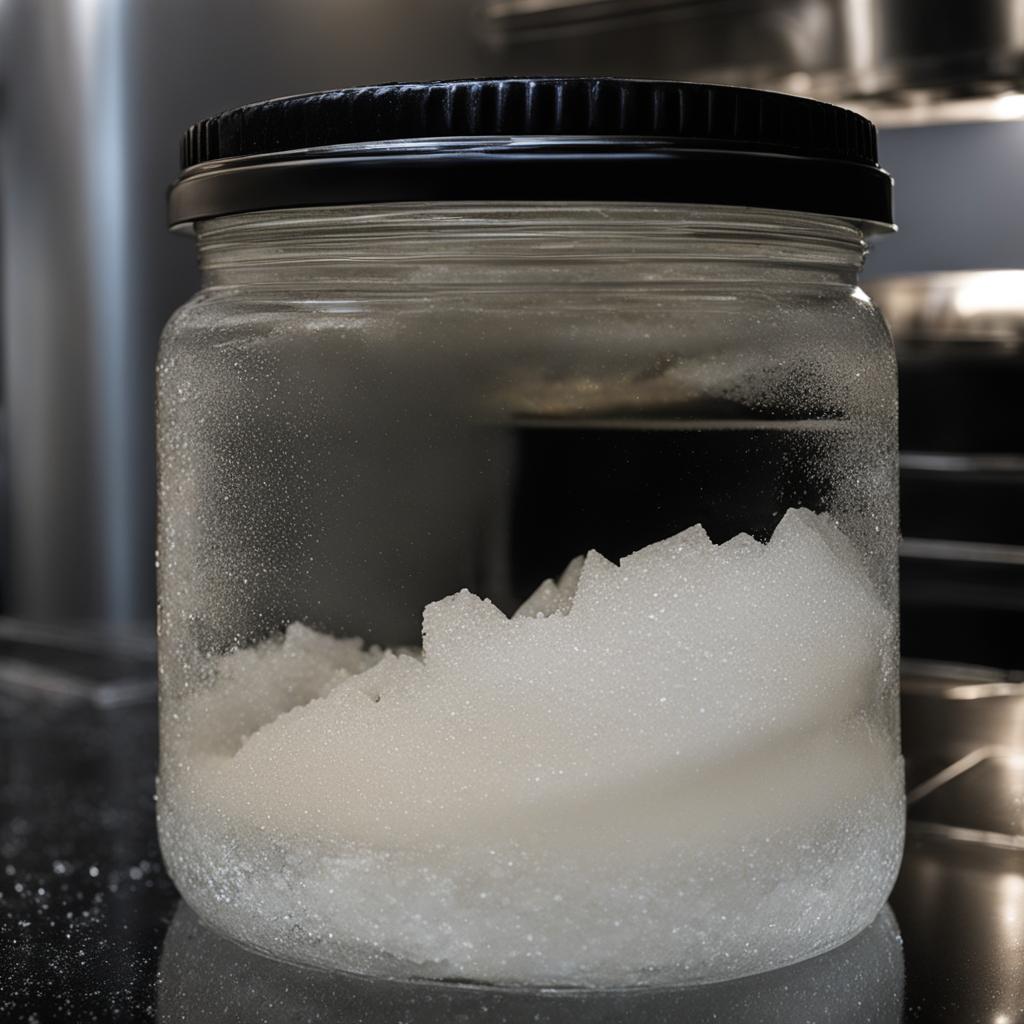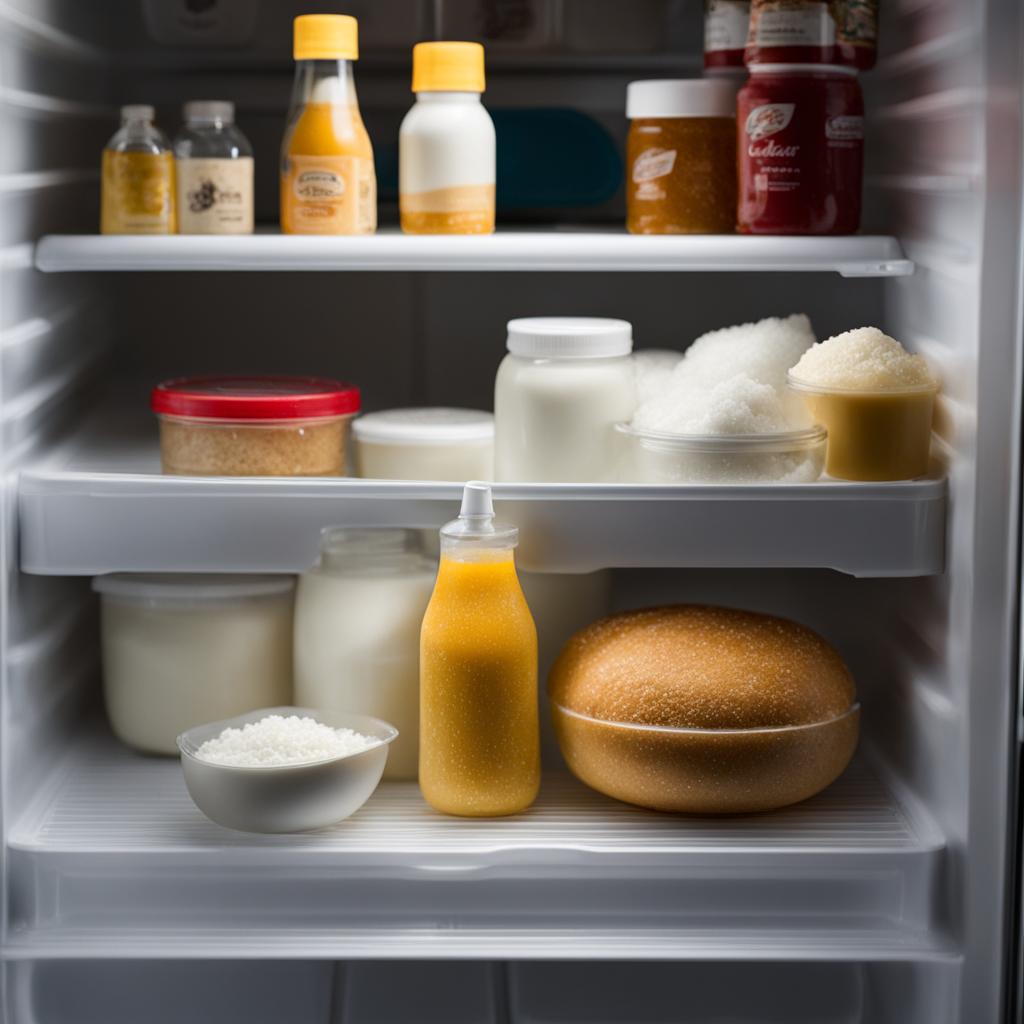Greetings, fellow food enthusiasts! Today, I want to shed some light on a topic that often raises eyebrows: freezing sour cream. Yes, you read that right! Contrary to popular belief, sour cream can indeed be frozen and used later with the right precautions and techniques.
Whether you’re dealing with leftovers, striving to minimize food waste, or simply planning ahead, freezing sour cream can be a handy option. By understanding the ins and outs of freezing this dairy product, you can ensure its quality and taste remain intact for future use.
So, let’s dive into the details of freezing sour cream and uncover the secrets to successfully preserving this creamy goodness.
Key Takeaways:
- Freezing sour cream is a viable option for preserving this dairy product.
- Proper techniques and precautions must be followed to maintain the quality and taste after thawing.
- While the texture may change, frozen sour cream can still be used in various recipes such as cakes, casseroles, and soups.
- Labeling, portioning, and date marking are crucial for organizing and maintaining frozen sour cream.
- Thawed sour cream should be used promptly to ensure the best flavor and quality.
How to Freeze Sour Cream
Freezing sour cream is a simple process that can help you extend its shelf life and prevent food waste. By following a few key techniques, you can ensure that your sour cream remains fresh and flavorful when you’re ready to use it. Here’s a step-by-step guide on how to freeze sour cream:
Freezing Techniques
Whip the sour cream with a whisk to distribute the moisture evenly throughout. This will help maintain its texture when frozen and thawed. Transfer the whipped sour cream to an airtight storage container or freezer bag. Make sure to squeeze out any excess air from the container or bag before sealing it.
Container Choice and Portion Sizes
Choose a container or freezer bag that is suitable for storing sour cream. It should be sturdy, leak-proof, and capable of withstanding freezer temperatures. It’s best to freeze sour cream in smaller portions to easily thaw only what you need. This will prevent you from having to refreeze any leftover sour cream, which can affect its quality.
Labeling and Date Marking
Proper labeling and date marking are crucial when freezing sour cream. Use a permanent marker to clearly label the container or bag with the date of freezing. This will help you keep track of its storage time and ensure that you use the sour cream within a safe time frame.
By following these freezing techniques and guidelines, you can freeze sour cream effectively and have it ready for future culinary creations. Now that you know how to freeze sour cream, you can confidently stock up on this versatile ingredient without worrying about it going to waste.
Thawing Frozen Sour Cream
Thawing frozen sour cream is a simple process that requires a little bit of patience. To maintain the best quality and flavor, it’s important to follow the proper thawing techniques. Start by transferring the desired amount of frozen sour cream to the refrigerator. Allow it to thaw slowly for several hours or overnight. This gradual thawing process helps maintain the integrity of the sour cream and prevents it from becoming watery.
It’s important to note that the texture of thawed sour cream may change, with the fats separating from the liquid part. Don’t worry, though! You can easily restore its smooth consistency by whipping it with a whisk. If you find that the texture is still not to your liking, you can add a teaspoon of cornstarch while whisking to further improve its consistency.
Once thawed, it’s best to use the sour cream as soon as possible. Like any dairy product, thawed sour cream continues to deteriorate over time and may develop off flavors or spoil. By using it promptly, you can ensure that you’re enjoying the best quality and flavor.
Tips for Thawing Frozen Sour Cream:
- Transfer frozen sour cream to the refrigerator and allow it to thaw slowly for several hours or overnight.
- Whip thawed sour cream with a whisk to restore its smooth consistency.
- Add a teaspoon of cornstarch while whisking if the texture is not to your liking.
- Use thawed sour cream promptly to enjoy the best quality and flavor.
| Thawing Tips | Description |
|---|---|
| Transfer to the refrigerator | Thaw frozen sour cream slowly by transferring it to the refrigerator for several hours or overnight. |
| Whip it up | Whip thawed sour cream with a whisk to restore its smooth consistency. |
| Add cornstarch | If the texture is not to your liking, add a teaspoon of cornstarch while whisking to improve its consistency. |
| Use it promptly | Thawed sour cream should be used as soon as possible to maintain the best quality and flavor. |
Sour Cream Uses in Recipes
Sour cream is a versatile ingredient that can be used in various recipes to enhance flavor and add creaminess. While it may not be suitable for dips or tangy toppings after freezing, the change in texture is less noticeable when incorporated into cooked dishes such as cakes, casseroles, and soups.
When using frozen sour cream in recipes, it’s important to consider the consistency. The texture of frozen sour cream may become slightly grainy or lumpy once thawed, but this can be easily smoothed out by stirring or whipping. Adding a teaspoon of cornstarch and incorporating it thoroughly can further improve the consistency.
Whether you’re making a rich and creamy cheesecake, a savory casserole, or a comforting bowl of soup, frozen sour cream can still provide a delicious and tangy flavor. Don’t let the change in texture discourage you from utilizing this versatile ingredient in your culinary creations.
Recipes that Benefit from Frozen Sour Cream:
- Creamy tomato soup
- Chicken and sour cream casserole
- Sour cream pound cake
- Baked potatoes with sour cream and chives
- Beef stroganoff
Experimenting with frozen sour cream in various recipes can lead to delightful culinary discoveries. Don’t be afraid to get creative and see how this versatile ingredient can elevate your dishes with its unique tangy flavor and creamy consistency.
| Recipe | Instructions |
|---|---|
| Creamy Tomato Soup | 1. In a pot, sauté onions and garlic until fragrant. 2. Add canned tomatoes and vegetable broth. 3. Simmer for 15 minutes and blend until smooth. 4. Stir in thawed sour cream and heat through. 5. Season with salt and pepper to taste. |
| Chicken and Sour Cream Casserole | 1. Cook chicken breast and dice into bite-sized pieces. 2. Mix together cooked pasta, diced chicken, thawed sour cream, and your favorite seasonings. 3. Transfer to a baking dish and top with shredded cheese. 4. Bake at 350°F (175°C) for 20-25 minutes, or until bubbly and golden. |
| Sour Cream Pound Cake | 1. Cream together butter and sugar until light and fluffy. 2. Beat in eggs, one at a time. 3. Mix in vanilla extract and almond extract. 4. In a separate bowl, whisk together flour, baking powder, and salt. 5. Gradually add the dry ingredients to the wet mixture, alternating with thawed sour cream. 6. Pour batter into a greased loaf pan and bake at 325°F (165°C) for about 60-70 minutes, or until a toothpick inserted into the center comes out clean. |
Tips for Freezing Sour Cream
Freezing sour cream is a convenient way to extend its shelf life and ensure you always have some on hand for your culinary creations. Here are some helpful tips to make the freezing process a success:
- Choose fresh sour cream: Prior to freezing, make sure your sour cream is fresh and hasn’t been open for more than three weeks. This will ensure optimal taste and quality after thawing.
- Divide into smaller portions: Instead of freezing the entire container, divide the sour cream into smaller portions. This makes it easier to thaw only what you need, reducing waste and ensuring the best texture.
- Use suitable containers: Transfer the sour cream to airtight storage containers or freezer bags. Be sure to squeeze out any excess air before sealing to prevent freezer burn.
- Label and date: Properly label each container with the date of freezing. This will help you keep track of the storage time and ensure you use the sour cream within the recommended timeframe.
By following these freezing tips, you can safely store sour cream in the freezer for future use. Remember to thaw only the amount you need and avoid refreezing previously thawed sour cream to maintain its quality.
Tips for Safe Food Storage
When it comes to freezing sour cream or any other food, it’s important to follow safe food storage practices. Here are some general tips for safe food storage:
- Keep your freezer at a consistent temperature of 0°F (-18°C) or below to prevent bacteria growth.
- Ensure the freezer is clean and organized, with proper airflow to maintain a constant temperature.
- Regularly check the expiration dates of frozen items and consume them within the recommended timeframe for the best quality.
By incorporating these tips into your meal planning and culinary arts, you can make the most of your frozen sour cream and other freezer-friendly ingredients. Enjoy the convenience of having sour cream readily available whenever you need it, and explore new recipes and dishes with confidence!
| Freezing Tips | Benefits |
|---|---|
| Choose fresh sour cream | Ensures optimal taste and quality after thawing |
| Divide into smaller portions | Easier to thaw only what you need, reduces waste |
| Use suitable containers | Airtight storage containers or freezer bags prevent freezer burn |
| Label and date | Keeps track of storage time, use within recommended timeframe |
Can Sour Cream Frosting Be Frozen?
When it comes to freezing dairy products, sour cream frosting is an exception to the rule. Unlike sour cream used in dips or as a topping, sour cream frosting can be frozen without significant texture changes. The additional ingredients used in sour cream frosting, such as powdered sugar and butter, help maintain its texture and stability after thawing. So, if you find yourself with leftover sour cream frosting, don’t hesitate to freeze it for future use.
To freeze sour cream frosting, follow these simple steps:
- Transfer the frosting to an airtight container or freezer bag.
- Press out any excess air to prevent freezer burn.
- Label the container with the date of freezing.
- Place it in the freezer, where it can be stored for up to three months.
When you’re ready to use the frozen sour cream frosting, thaw it in the refrigerator overnight. Once thawed, give it a quick stir or beat it with an electric mixer to restore its creamy consistency. The thawed sour cream frosting should be just as delicious and spreadable as when it was freshly made.
In conclusion, freezing sour cream frosting is a great way to extend its shelf life and reduce food waste. By following proper preparation and storage techniques, you can enjoy the convenience of having homemade frosting ready whenever you need it.
The Texture Changes of Frozen Sour Cream
When sour cream is frozen and then thawed, you may notice some changes in its texture and consistency. Freezing can cause the fats in sour cream to separate from the liquid part, resulting in a lumpy or grainy texture once thawed. This change in texture can make it unsuitable for certain uses, such as dips or toppings. However, in cooked dishes like cakes, casseroles, and soups, the texture changes are often less noticeable, allowing you to still enjoy the flavor and creaminess of the sour cream.
It’s important to note that while the texture may change, the overall flavor of the sour cream typically remains intact. The tangy and creamy taste that sour cream is known for can still be enjoyed even after freezing and thawing. So, if you’re planning to use frozen sour cream in a recipe that involves cooking or baking, you can still incorporate it without significant impact on the final result.
To minimize the effects of texture changes, you can also try whipping the thawed sour cream with a whisk to help bring it back to a smoother consistency. Additionally, some individuals find that adding a teaspoon of cornstarch to the whipped sour cream can further improve its texture.
The Texture Changes of Frozen Sour Cream
| Texture Changes | Consistency | Flavor Changes |
|---|---|---|
| Lumpy or grainy | Changes in smoothness | Remains tangy and creamy |
| More noticeable in dips and toppings | Still suitable for cooked dishes | Overall flavor remains intact |
Shelf Life and Food Safety of Frozen Sour Cream
When it comes to freezing sour cream, ensuring its quality and safety is crucial. While frozen sour cream is safe to eat after thawing, it’s important to understand its shelf life and potential flavor changes. By following proper storage practices and paying attention to signs of spoilage, you can enjoy frozen sour cream without any concerns.
Like any dairy product, sour cream is susceptible to bacterial growth if not stored correctly. Freezing sour cream can help extend its shelf life, but it’s best to use it within six months for optimal taste and texture. Beyond this timeframe, the quality may decline, and the sour cream may develop off smells, mold, or discoloration, indicating spoilage.
To ensure safe consumption, it’s essential to always check the sour cream for any signs of spoilage before using it. If you encounter any off smells, mold, or unusual colors, it’s best to discard the sour cream to avoid the risk of foodborne illness. Quality assurance is key in maintaining the safety of frozen sour cream.
| Safe Consumption of Frozen Sour Cream | Signs of Spoilage |
|---|---|
| Use within six months for best quality | Off smells: sour, rotten, or unpleasant odor |
| Mold: visible growth or discoloration | |
| Unusual colors: yellow, green, or pink |
By following these guidelines, you can confidently freeze sour cream and enjoy it safely for an extended period. Remember to always practice proper food safety measures and trust your senses when assessing the quality of frozen sour cream.
Using Leftover Sour Cream
If you have leftover sour cream that you won’t use before it expires, don’t let it go to waste! Freezing sour cream is a great way to extend its shelf life and ensure you always have some on hand for future recipes. By following the proper freezing and thawing techniques, you can still utilize the sour cream in various dishes and reduce kitchen waste.
When freezing leftover sour cream, make sure it is in an airtight container or freezer bag to prevent freezer burn and maintain its freshness. It’s best to freeze sour cream in smaller portions, so you can easily thaw only what you need for your next recipe. Properly labeling the container with the date will help you keep track of its storage time in the freezer.
Thawing frozen sour cream is simple. Just transfer the desired amount to the refrigerator and allow it to thaw for several hours. The texture may become watery and separated, but you can whip it with a whisk to reach a smooth consistency. If needed, adding a teaspoon of cornstarch and whipping it again can further improve the texture. Remember to use the thawed sour cream sooner rather than later, as it continues to deteriorate over time.
| Leftover Sour Cream Storage Tips | |
|---|---|
| Properly seal sour cream in an airtight container |  |
| Freeze in smaller portions for easier thawing | |
| Label container with the date | |
| Thaw in the refrigerator for several hours | |
| Whip thawed sour cream to improve texture |
Freezing leftover sour cream is a handy solution for preventing food waste and maximizing your ingredients. Next time you find yourself with extra sour cream, freeze it and take advantage of its versatility in various recipes. Whether it’s a creamy dip, a luscious casserole, or a comforting soup, your frozen sour cream will add a tangy and rich flavor to your culinary creations.
Similarity and Substitutes for Sour Cream
When it comes to dairy products, sour cream is a popular choice for its tangy flavor and creamy texture. However, if you find yourself without sour cream in your refrigerator, there are a few substitutes that can provide a similar taste and texture. Yogurt and Crème fraîche are two excellent alternatives to sour cream, as they are all forms of curdled milk.
Yogurt: Yogurt is a versatile dairy product that can be used as a substitute for sour cream in many recipes. It has a slightly tangy flavor and a creamy texture, making it a suitable replacement. Opt for plain and unsweetened yogurt to achieve the closest flavor profile to sour cream.
Crème fraîche: Crème fraîche is a French cultured cream that shares similarities with sour cream. It has a rich and tangy flavor with a thick and creamy consistency. It can be used as a substitute in both sweet and savory dishes, adding a touch of indulgence to your recipes.
These substitutes can be used interchangeably with sour cream in various recipes, such as dips, sauces, dressings, and baked goods. Experiment with different ratios to achieve the desired taste and consistency in your dishes. Whether you have yogurt or Crème fraîche on hand, these alternatives can help you achieve that creamy and tangy flavor you love.
| Substitute | Flavor | Consistency |
|---|---|---|
| Yogurt | Slightly tangy | Creamy |
| Crème fraîche | Rich and tangy | Thick and creamy |
| Sour Cream | Tangy | Creamy |
Freezing Tips for Other Dairy Products
When it comes to preserving dairy products, freezing can be a challenging task. Similar to sour cream, other dairy products may undergo texture changes after thawing. However, with the right techniques, you can still freeze and maintain the quality of various dairy products. Here are some freezing tips for other commonly used dairy products:
Cream Cheese:
Cream cheese can be frozen, but it may become crumbly or grainy after thawing. To freeze cream cheese, wrap it tightly in plastic wrap or place it in an airtight container. When ready to use, thaw it in the refrigerator overnight and then stir it well to restore its creamy consistency. While it may not be as smooth as fresh cream cheese, it can still be used in recipes like cheesecake or frosting.
Yogurt:
Freezing yogurt can change its texture and make it grainy or watery upon thawing. However, frozen yogurt can still be used in smoothies or as a base for homemade frozen treats. For best results, freeze yogurt in individual portions using an ice cube tray or silicone molds. Once frozen, transfer the yogurt cubes to a freezer bag and label them with the date. When needed, simply blend the frozen yogurt with other ingredients to create a refreshing and nutritious treat.
Buttermilk:
Buttermilk can be frozen, but it may separate or become lumpy after thawing. To freeze buttermilk, pour it into an airtight container, leaving some space for expansion, and seal it tightly. Thaw the frozen buttermilk overnight in the refrigerator and give it a good shake or whisk before using it in recipes. While the texture may change, the flavor and tanginess of the buttermilk will remain.
Remember to always label and date your frozen dairy products to ensure proper rotation and prevent food waste. While the texture changes may be noticeable, these frozen dairy products can still be used in various recipes, allowing you to make the most of your dairy products and reduce kitchen waste.
How to Store Sour Cream in the Refrigerator
Properly storing sour cream in the refrigerator is essential to maintain its freshness and extend its shelf life. By following a few simple steps, you can ensure that your sour cream stays creamy and delicious for as long as possible.
First, it’s important to keep the sour cream in its original container or transfer it to an airtight storage container. This will help prevent air from entering and affecting the quality of the sour cream. Make sure the container is clean and dry before placing the sour cream inside.
Next, store the sour cream in the coldest part of the refrigerator, usually the back of the lower shelves. This area maintains a consistent temperature and minimizes exposure to warm air when opening and closing the refrigerator door. Keeping the sour cream away from the door will also prevent temperature fluctuations that can compromise its freshness.
Lastly, check the expiration date on the sour cream container and adhere to it. Sour cream typically has a shelf life of one to three weeks when properly refrigerated. Using sour cream past its expiration date may result in a sour taste and decreased quality. If the sour cream shows signs of spoilage, such as mold or an off smell, it’s best to discard it.

The Benefits of Proper Refrigeration
Storing sour cream in the refrigerator provides several benefits. Firstly, it helps maintain the freshness and quality of the sour cream. The cool temperature slows down bacterial growth and helps preserve the taste and texture. Additionally, refrigerating sour cream prevents it from separating or becoming watery, ensuring a smooth and creamy consistency.
Proper refrigeration also reduces the risk of foodborne illnesses. The cold temperature inhibits the growth of harmful bacteria, such as Salmonella and E. coli, which can thrive in warmer environments. By storing sour cream at a consistently low temperature, you can enjoy it safely and without any health concerns.
To summarize, refrigerating sour cream in a sealed container and placing it in the coldest part of the refrigerator helps maintain its freshness, creaminess, and safety. Following these storage guidelines will ensure that your sour cream is always ready to add a tangy and creamy touch to your favorite recipes.
Using Frozen Sour Cream in Baking
If you have frozen sour cream on hand and you’re in the mood for some baking, you’re in luck! Frozen sour cream can be a fantastic addition to your baking recipes, adding moisture and richness to your favorite treats. Whether you’re making cakes, muffins, or cookies, incorporating thawed sour cream can elevate the flavor and texture of your baked goods.
When using frozen sour cream in baking, it’s important to thaw it properly before adding it to your recipe. Transfer the desired amount of frozen sour cream to the refrigerator and allow it to thaw for several hours or overnight. Once thawed, give it a good stir to achieve a smooth consistency.
Now, let’s take a look at some popular baked goods where frozen sour cream can work its magic:
Cakes:
- Add thawed sour cream to your cake batter for a moist and tender crumb.
- Try using it in chocolate cakes, carrot cakes, or even pound cakes for an extra layer of flavor.
Muffins:
- Swap some of the liquid ingredients in your muffin recipe with thawed sour cream for a soft and fluffy texture.
- Blueberry muffins, banana muffins, and bran muffins can all benefit from the addition of sour cream.
Cookies:
- Replace a portion of the butter in your cookie dough with thawed sour cream for a tender and chewy result.
- Chocolate chip cookies, oatmeal cookies, and sugar cookies can all be enhanced with sour cream.
Remember, when using frozen sour cream in baking, it’s always a good idea to experiment and adjust your recipe to suit your taste preferences. Enjoy the creamy and tangy goodness that sour cream brings to your homemade treats!
Image source: https://seowriting.ai/32_6.png
Sour Cream Nutritional Benefits
Sour cream not only adds a creamy and tangy flavor to dishes, but it also provides various nutritional benefits. Incorporating sour cream into your diet can help you meet your daily requirements of important vitamins and minerals.
One of the key nutritional benefits of sour cream is its high content of vitamin A. This essential vitamin plays a vital role in maintaining healthy vision, supporting immune function, and promoting cell growth and development.
Sour cream is also a good source of vitamin E, which is known for its antioxidant properties. Vitamin E helps protect the body’s cells from damage caused by harmful free radicals, potentially reducing the risk of chronic diseases.
In addition to vitamins A and E, sour cream contains important minerals like calcium, phosphorus, and selenium. Calcium is essential for maintaining healthy bones and teeth, while phosphorus plays a role in energy production and cell function. Selenium is a trace mineral that acts as an antioxidant and supports a healthy immune system.
| Nutrient | Amount per 100g |
|---|---|
| Vitamin A | 150 IU |
| Vitamin E | 0.45 mg |
| Calcium | 110 mg |
| Phosphorus | 92 mg |
| Selenium | 2.1 mcg |
Adding sour cream to your meals not only enhances the taste but also boosts the nutritional value. However, it’s important to consume sour cream in moderation as it is high in calories and fat. Be mindful of portion sizes and incorporate sour cream as part of a balanced diet.
Freezing Sour Cream: A Practical Overview
When it comes to food preservation in the culinary world, freezing is a handy technique that extends the shelf life of various ingredients. Sour cream, a versatile dairy product commonly used in cooking and baking, is no exception. By understanding the proper methods and temperature control, you can successfully freeze sour cream, ensuring its freshness and quality when you need it.
One crucial aspect of freezing sour cream is choosing the right container. Opt for airtight storage containers or freezer bags to minimize the risk of freezer burn and keep out any unwanted odors. It’s also recommended to divide the sour cream into smaller portions before freezing. This allows you to thaw only the amount needed for your recipe, preventing unnecessary waste.
Thawing frozen sour cream is a straightforward process. Simply transfer the desired amount to the refrigerator and let it thaw for several hours. However, keep in mind that the texture of the sour cream may change after thawing, becoming slightly watery or separated. To restore a smooth consistency, whisk the thawed sour cream vigorously or add a teaspoon of cornstarch and whisk again until smooth.
Freezing sour cream is a practical solution for preserving this dairy product and reducing food waste in your kitchen. By following the recommended steps and temperature control, you can maintain the quality and safety of frozen sour cream. Explore the culinary possibilities of frozen sour cream by incorporating it into your favorite recipes, and enjoy the convenience of having this creamy and tangy ingredient readily available.
Conclusion
In conclusion, freezing sour cream can be a practical solution for preserving this versatile dairy product. Although the texture may change after thawing, proper freezing and thawing techniques can ensure its safe consumption and enhance its culinary uses. By following the recommended steps, you can extend the shelf life of sour cream and reduce food waste in your kitchen.
Experimenting with frozen sour cream in various recipes such as cakes, casseroles, and soups can still provide a creamy and tangy flavor to your dishes. While it may not be suitable for dips or toppings, incorporating thawed sour cream into cooked dishes allows you to enjoy its flavor without compromising the final result.
So, next time you find yourself with leftover sour cream or need to preserve it before it expires, consider freezing it using the techniques outlined in this article. With proper storage and thawing, you can make the most of this dairy product and elevate your culinary creations. Give frozen sour cream a try and discover its versatility in your cooking endeavors!
FAQ
Can you freeze sour cream?
Yes, sour cream can be safely frozen and thawed for various cooking and baking needs.
How do you freeze sour cream?
Whip the sour cream with a whisk, transfer it to an airtight container or freezer bag, remove excess air, and label the container with the date.
How do you thaw frozen sour cream?
Transfer the desired amount to the fridge and allow it to thaw for several hours. Whip with a whisk to reach a smooth consistency.
Can you use frozen sour cream in dips or as a topping?
No, the texture may change after thawing, making it unsuitable for dips or tangy toppings.
What can you use thawed sour cream for?
Thawed sour cream can still be used in cakes, casseroles, and soups, where the texture changes are less noticeable in cooked dishes.
How long can you freeze sour cream?
It is recommended to use frozen sour cream within six months for the best taste and texture.
Can you freeze sour cream frosting?
Yes, sour cream frosting can be frozen and whipped back to a frosting consistency when needed.
What happens to the texture of frozen sour cream?
The fats may separate from the liquid part, resulting in a lumpy or grainy texture once thawed.
How long can sour cream be stored in the refrigerator?
Refrigerated sour cream can last for one to three weeks, depending on the expiration date and storage conditions.
Can sour cream substitutes be used in recipes?
Yes, yogurt, Crème fraîche, and curdled milk can be used interchangeably as substitutes for sour cream in many recipes.
Can other dairy products be frozen?
Yes, similar techniques can be applied to other dairy products like cream cheese or yogurt to maintain their quality when frozen.
What are the nutritional benefits of sour cream?
Sour cream is rich in vitamin A, vitamin E, calcium, phosphorus, and selenium, which are essential for maintaining good health.
How can freezing sour cream help reduce food waste?
Freezing leftover sour cream can prevent it from going to waste and allow you to utilize it in various recipes.
Can frozen sour cream be used in baking?
Yes, incorporating thawed sour cream into baked goods can add moisture and richness to the final product.
What is the shelf life and food safety of frozen sour cream?
Frozen sour cream is safe to eat even after being thawed, but its quality may decline over time. Proper storage and usage are essential for food safety.
How can I store sour cream in the refrigerator?
Ensure the sour cream is properly sealed in its original container or transferred to an airtight storage container for refrigeration.
How can freezing sour cream preserve it?
Freezing sour cream is a practical method of preserving it, extending its shelf life and reducing food waste when done correctly.
Source Links
- https://www.bhg.com/can-you-freeze-sour-cream-7092237
- https://www.usatoday.com/story/life/food-dining/2022/08/19/can-you-freeze-sour-cream/10216646002/
- https://www.allrecipes.com/article/can-you-freeze-sour-cream/
Related Recipes:
 How to Freeze Bananas? (Perfect Step-By-Step Guide)
How to Freeze Bananas? (Perfect Step-By-Step Guide)
 Can You Freeze Garlic? Here’s How to Do It Right.
Can You Freeze Garlic? Here’s How to Do It Right.
 How to Freeze Avocados? (Perfect Step-By-Step Guide)
How to Freeze Avocados? (Perfect Step-By-Step Guide)
 How to Freeze Spinach? (Perfect Step-By-Step Guide)
How to Freeze Spinach? (Perfect Step-By-Step Guide)
 How To Freeze Rhubarb (Perfect For Long Term Storage)
How To Freeze Rhubarb (Perfect For Long Term Storage)
 How to Freeze Oranges: Keep Citrus Fresh for Longer
How to Freeze Oranges: Keep Citrus Fresh for Longer
 How to Freeze Carrots: A Step-by-Step Guide
How to Freeze Carrots: A Step-by-Step Guide
 Can You Freeze Chicken Salad? Tips and Considerations
Can You Freeze Chicken Salad? Tips and Considerations








